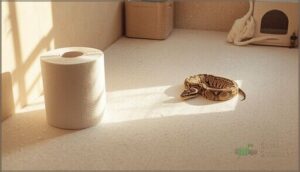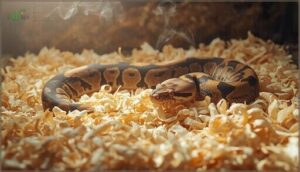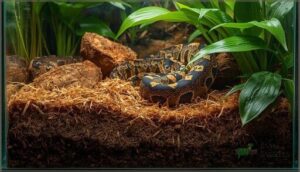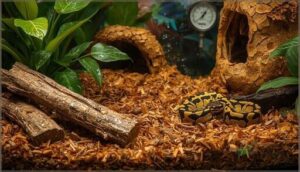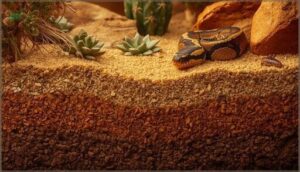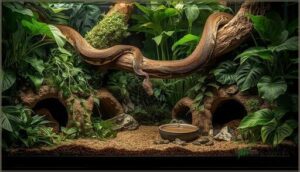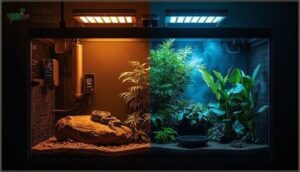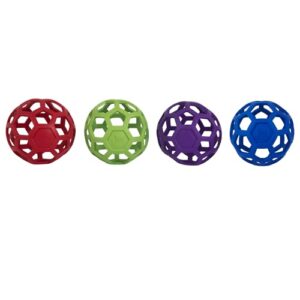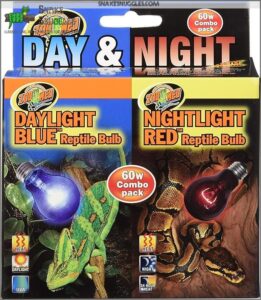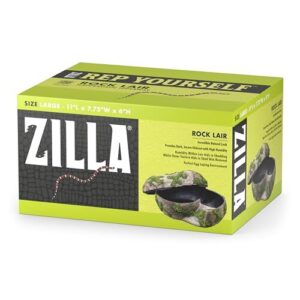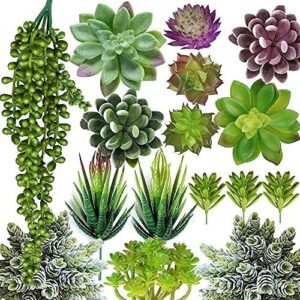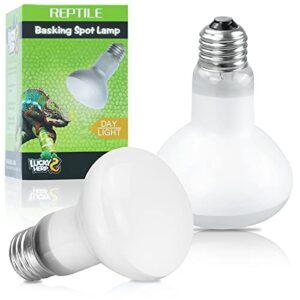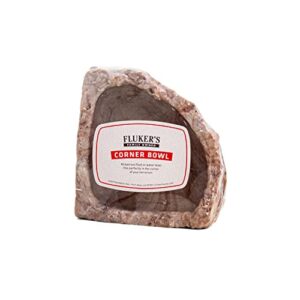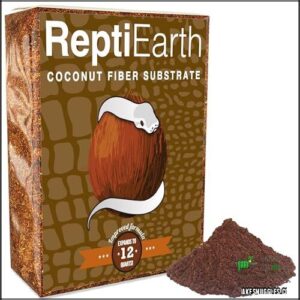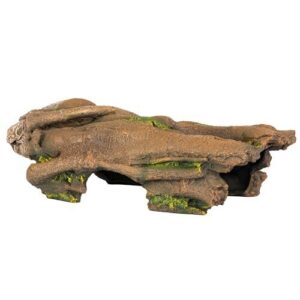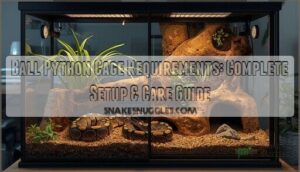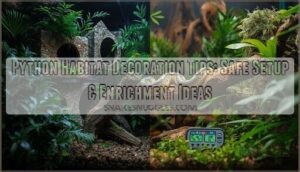This site is supported by our readers. We may earn a commission, at no cost to you, if you purchase through links.
Your python’s enclosure isn’t just a box—it’s the foundation of its physical health and psychological well-being. A poorly designed habitat triggers chronic stress, suppresses immune function, and shortens lifespan, while a thoughtfully constructed environment fosters natural behaviors and reduces disease risk.
The difference often comes down to details most keepers overlook: temperature gradients that allow proper thermoregulation, substrate choices that maintain humidity without harboring pathogens, and spatial design that accommodates both terrestrial and climbing behaviors.
Getting python snake habitat design right means understanding how enclosure materials, heating systems, substrate options, and environmental enrichment work together to replicate the conditions your snake needs to thrive.
Table Of Contents
- Key Takeaways
- Key Considerations for Python Habitat Design
- Selecting Substrate and Flooring Options
- Essential Decor and Environmental Enrichment
- Heating, Lighting, and Humidity Control
- Top 10 Products for Python Habitat Design
- 1. Natural Rubber Dog Puzzle Ball
- 2. Reptile Day And Night Bulbs
- 3. Clay Burrow Substrate For Reptiles
- 4. Zilla Rock Lair Reptile Hide
- 5. Artificial Succulent Plant Set
- 6. Reptile Heat Lamp Bulbs Set
- 7. Reptile Corner Food Water Bowl
- 8. Coconut Fiber Reptile Bedding Substrate
- 9. Natural Reptile Hollow Log Hide
- 10. Exo Terra Reptile Water Dish Large
- Frequently Asked Questions (FAQs)
- Conclusion
Key Takeaways
- Temperature gradients (88-92°F warm side, 76-80°F cool side) and humidity control (50-80% depending on species) are non-negotiable foundations that directly impact your python’s digestion, immunity, and shedding success.
- Enclosure size and material matter more than most keepers realize—PVC retains heat better than glass, and adult ball pythons need a minimum of 4x2x2 feet to move naturally and regulate body temperature effectively.
- Strategic enrichment like climbing branches, hides on both warm and cool sides, and burrowing substrate reduces stress hormones by 21-43% while encouraging natural behaviors that keep your snake mentally and physically healthy.
- Substrate selection shapes your entire maintenance routine—coconut fiber holds moisture for a week and resists fungal growth, while paper towels demand daily changes but offer simplicity for quarantine situations.
Key Considerations for Python Habitat Design
Getting your python’s habitat right isn’t just about throwing together a tank and some decorations—it’s about understanding what your snake actually needs to thrive. From choosing the right enclosure dimensions to managing temperature zones and airflow, each decision directly impacts your python’s health and behavior.
Let’s walk through the core elements you’ll need to think about before you start building out the perfect setup.
Choosing The Right Enclosure Size and Material
Your python’s enclosure acts as its entire world, so getting the size and material right matters. Adult ball pythons need at least 4 feet by 2 feet by 2 feet—think 65 to 75 gallons—to move naturally and regulate body temperature.
PVC enclosures lead in heat retention and moisture resistance, while glass loses warmth quickly. A well-designed enclosure can also incorporate multiple climbing opportunities for enrichment.
Choose materials that balance durability, safety, and reduced visibility stress for shy species.
Maintaining Optimal Temperature and Humidity
Once you’ve sorted the enclosure, your focus shifts to temperature and humidity—both directly affect digestion, shedding, and immunity. Maintaining temperature gradients means setting your basking spot at 88-92°F and the cool side at 76-80°F. Monitoring methods like digital probes prevent guesswork. During shedding cycles, boost humidity to 70-80% to avoid stuck shed. Optimal humidity is key for reptile health.
Consider these essentials for humidity control and health impacts:
- Keep daily humidity between 50-60% for ball pythons
- Use infrared thermometers to check warm and cool zones
- Species adaptability varies—green tree pythons need higher moisture levels
Ensuring Security, Accessibility, and Ventilation
Now that you’ve nailed the climate, focus on keeping your python safe inside. Escape prevention starts with a secure, lockable lid—over 60% of incidents stem from poorly fitted tops.
Ventilation standards call for at least two air vents to cut respiratory issues by 25%.
Accessibility design matters too: front-opening doors reduce stress during feeding and cleaning, making routine care safer for you and your snake.
Species-Specific Enclosure Requirements
Different snake species requirements shape every habitat decision you’ll make. Ball pythons need 36″ x 18″ x 12″ enclosures minimum with substrate depth between 10–35 cm for natural burrowing. Reticulated pythons demand 8′ x 3′ x 3′ spaces with 10–15 cm substrate and 60–80% humidity levels.
Temperature gradients, hide placement, and environmental needs vary dramatically—creating snake habitats means matching enclosure dimensions to your python’s actual biology.
Selecting Substrate and Flooring Options
Choosing the right substrate for your python’s enclosure affects everything from humidity retention to cleaning routines. The flooring you select should match your snake’s natural environment while fitting your maintenance preferences and experience level.
Below are five substrate options, each with distinct advantages for different habitat setups and care approaches.
Paper Towels for Easy Maintenance
When you need a substrate choice that puts cleaning and maintenance front and center, paper towels deliver unparalleled simplicity. This option shines for quarantine setups or sick pythons, making reptile care straightforward while maintaining temperature and humidity with strategic misting.
- Absorbency levels: Immediate waste visibility allows rapid cleanup, reducing bacterial buildup
- Cleaning frequency: Full replacement every 1–3 days prevents microbial growth and odor
- Humidity boosting: Dampened layers maintain 50–60% humidity, supporting healthy sheds
- Cost effectiveness: One roll lasts up to two weeks for a juvenile python
- Chemical risks: Choose unbleached, food-grade products to avoid chlorine and formaldehyde exposure
Aspen Bedding for Odor Control
If you’re looking for a substrate choice that confronts odor head-on, aspen bedding delivers impressive ammonia binding and waste absorption.
This substrate keeps enclosure air quality high—pythons housed on aspen show 30% fewer respiratory health issues compared to other options.
With proper spot-cleaning, its lifespan stretches up to 18 days while maintaining strong microbial control and odor control throughout.
Coconut Husk and Fiber Substrates
When your python’s enclosure demands both humidity retention and mold resistance, coconut husk and coconut fiber substrate deliver. This material holds moisture up to 60% of its weight, stabilizing humidity control at ideal levels between 60–70%.
You’ll notice improved burrowing comfort as the soil-like texture encourages natural digging behaviors.
Watch for ingestion risks during feeding—larger husk chips require careful monitoring—and expect increased cleaning frequency since darker substrate camouflages waste effectively.
Cypress Mulch for Moisture and Fungal Control
Cypress mulch stands out for its dual advantage: outstanding humidity retention and built-in mold resistance through natural antifungal oils. You’ll maintain stable moisture levels for tropical pythons while supporting natural burrowing behavior in layered setups.
Keep these priorities in mind:
- Use 3–4 inch layers to amplify moisture-binding capacity
- Monitor for decomposition and dust accumulation weekly
- Verify your product contains no toxic pine or cedar contaminants
Regular spot-cleaning prevents bacterial buildup despite excellent fungal control.
Sandy Soil Mix for Desert-Themed Habitats
A proper desert landscape substrate balances aesthetics with safety. You’ll want a 70% soil, 20% sand, and 10% coconut fiber blend for Desert Oasis enclosures—this ratio minimizes impaction risks while supporting 8–12 inch burrowing depths.
Choose sand particles between 0.25–1.0 mm for dust control.
Maintain 20% moisture levels weekly to replicate arid landscapes without drying out completely.
Essential Decor and Environmental Enrichment
Your python’s enclosure shouldn’t just be a box—it needs to feel like a space where your snake can explore, hide, and behave naturally. The right combination of decor and enrichment items promotes both physical health and mental stimulation.
Let’s look at the essential elements that transform a basic setup into a habitat your python will actually use.
Climbing Branches, Ropes, and Driftwood
Over 90% of your python’s climbing happens at night, especially among males. That’s why secure climbing branches, ropes, and driftwood are essential enrichment elements.
Use hardwoods with smooth surfaces—never cedar or pine—and anchor them firmly to support your snake’s weight.
These climbing structures boost activity by 30% and satisfy natural arboreal behaviors, particularly for species like green tree pythons that thrive with vertical enrichment.
Artificial and Live Plants for Naturalistic Environments
While branches support your python’s physical activity, plants complete the naturalistic terrarium by enhancing behavioral enrichment and humidity contribution. Live tropical species like golden pothos show 80% survival rates in proper conditions while boosting humidity by 12%. Artificial plants require less maintenance but don’t regulate moisture or support ecological impact through beneficial microorganisms.
Artificial and Live Plant Choices for enrichment elements:
- Golden pothos thrives in 80% of enclosures, stabilizing humidity levels naturally
- Hardy succulents survive at 65% rates with minimal watering requirements
- Snake plants adapt to high-humidity environments when roots establish first
- Quality artificial options maintain appearance for two years without ecological benefits
Hide Boxes, Caves, and Hollow Logs
After setting up plants, your python needs proper hiding spots to feel secure. Hides positioned on both warm and cool sides let 96% of captive snakes regulate temperature without sacrificing security.
Choose material safety options like cork or resin that retain heat 18% longer than wood. Proper hide size—about 1.25 times your snake’s width—cuts stress hormones by 43% and defensive displays by half.
Moss Patches, Leaf Litter, and Burrowing Areas
Beyond hides, you’ll want to layer in moss patches and leaf litter—they’re not just decorative. Moistened sphagnum moss creates localized humidity zones between 60-80%, helping your python shed cleanly.
A 2-3 cm layer of leaf litter maintains humidity 10-15% higher than bare substrate, supports microfauna, and encourages burrowing behaviors. This enrichment boosts exploratory activity by 30% and reduces stress-related shedding issues by 21%.
Water Features and Soaking Dishes
Your python’s hydration station isn’t just a water bowl—it’s where thermoregulation meets hygiene. Choose a dish large enough for full-body soaking (roughly 1.25 times mid-body length) and place it on the cooler side to prevent overheating. Water quality matters: replace daily and disinfect weekly, because Salmonella thrives in biofilms at 45–105°F.
- Dish size: Adult ball pythons need 0.75–2.0 liter capacity for proper soaking frequency
- Material safety: Non-porous ceramic or food-grade plastic prevents bacterial colonization
- Placement strategy: Position away from heat sources to maintain stable water temperature
Enrichment Toys and Puzzle Balls
Surprisingly, puzzle balls and similar manipulable objects can actually enlarge your python’s brain. Research shows snakes in enriched environments with movable toys develop greater brain volume and perform better on cognitive tasks.
Research shows enriched environments with puzzle balls can enlarge your python’s brain and improve cognitive performance
Start with simple puzzle feeding devices—place prey inside modified dog puzzle balls on flat surfaces to avoid substrate ingestion. Always choose non-toxic, cleanable materials and monitor your snake’s initial response to new enrichment.
Heating, Lighting, and Humidity Control
Getting the temperature, humidity, and lighting right isn’t optional—it’s the foundation of keeping your python healthy. You’ll need to choose the right heating elements, maintain proper gradients, and monitor conditions consistently.
Here’s how to set up each component so your snake can thermoregulate and thrive in its enclosure.
Heat Lamps, Ceramic Emitters, and Under-Tank Pads
Choosing the right heating method can make or break your python’s health. Each heat source offers distinct advantages, and understanding their specific uses helps you create a safe, effective environment.
- Heat lamps positioned overhead deliver focused warmth for basking, ideal for ball pythons requiring 90–95°F zones
- Ceramic heat emitters convert nearly 100% of electrical input into radiant heat without emitting light
- Under-tank heat mats provide localized ground warmth for belly heat when properly regulated
- Thermostatic control prevents dangerous overheating across all heating methods
- External placement of heat sources eliminates direct contact burns and fire hazards
Creating Temperature Gradients
When your python can’t shuttle between hot and cool zones, it can’t thermoregulate properly. You’ll want a warm side basking spot at 88–92°F and a cool end around 76–80°F—at least a 10–15°F thermogradient across the enclosure.
Use gradient equipment like thermostats at multiple points to prevent dangerous spikes. Night temperatures can safely drop to 75–80°F, supporting natural thermal behavior and seasonal changes.
Monitoring and Adjusting Humidity With Hygrometers
You can’t manage what you don’t measure—that’s why hygrometers are essential for tracking humidity levels in your python’s enclosure. Digital models with ±2–3% accuracy work well; place the probe at snake level, ideally inside the warm hide, to monitor real-time moisture levels.
Check readings daily and adjust misting, substrate depth, or ventilation to keep humidity between 60–80% and prevent respiratory issues or shedding problems.
Low-Intensity and Warm-Toned LED Lighting
LEDs last 20,000–50,000 hours and emit minimal heat, making them ideal for python terrarium design ideas without disrupting temperature gradients. Warm-toned options mimic dusk conditions, supporting natural day-night cycle rhythms and reducing stress in ball pythons.
When selecting LED lighting for your terrarium, consider:
- Spectral output that includes UVA1 wavelengths for visual comfort
- Installation safety with 4–14 inch mounting distance above mesh
- Behavioral impact—keep intensity under 3,000 lumens to avoid overstimulation
Misting Systems for Tropical Enclosures
Automatic misting systems raise humidity above 90% during cycles in tropical python enclosures, then allow a gradual decline between events. Misting frequency should balance humidity spikes with ventilation needs—excessive moisture at warm temperatures accelerates bacterial growth dramatically.
Use distilled water to prevent nozzle clogging, and program short, frequent intervals for species requiring sustained high humidity. Pair your system with proper airflow to maintain healthy conditions without oversaturation.
Top 10 Products for Python Habitat Design
Building the right habitat for your python comes down to choosing products that support their health, behavior, and comfort.
The items below range from enrichment tools and heating solutions to substrates and water dishes that meet specific environmental needs.
Each product has a clear purpose in creating a functional, naturalistic enclosure your snake can thrive in.
1. Natural Rubber Dog Puzzle Ball
You mightn’t expect a dog toy in your python’s enclosure design, but natural rubber dog puzzle balls offer surprising behavioral benefits for reptile enrichment. Made from durable, non-toxic rubber, these spheres provide cognitive stimulation through manipulation and exploration, encouraging investigative behavior and spatial engagement.
Position them behind branches or within a naturalistic terrarium to boost environmental complexity. Market trends show growing demand for eco-friendly enrichment options, and these puzzle balls excel at replicating natural environments where snakes navigate obstacles. They’re safe, cleanable, and promote active foraging behaviors in captivity.
Best For: Reptile keepers looking to add affordable, durable enrichment that encourages natural foraging and exploration behaviors in snakes and other curious reptiles.
- Made from non-toxic natural rubber that’s safe for reptile enclosures and easy to clean with hot water
- Encourages investigative behavior and spatial exploration when positioned behind branches or plants
- Durable and eco-friendly alternative to plastic enrichment, with proven longevity in active use
- Engagement typically peaks in the first 24 hours as novelty wears off
- Not all reptile species show interest—leopard geckos and others may ignore them entirely
- Sized for dogs rather than reptiles, so finding the right fit for smaller enclosures can be tricky
2. Reptile Day And Night Bulbs
Zoo Med’s Day and Night Bulb combo provides 24-hour temperature control that aids your python’s circadian rhythms and thermoregulation needs. The daylight blue bulb delivers UVA rays for psychological health during the day, while the true red glass bulb allows nocturnal viewing without disrupting sleep cycles.
This pairing maintains your temperature gradient across day-night cycles—critical for metabolic function. However, bulb lifespan can be inconsistent, with some users reporting failures under 30 days. Energy efficiency remains moderate at 60 watts per bulb, so you’ll need to factor ongoing costs into your habitat maintenance budget.
Best For: Reptile owners who need an affordable day/night lighting solution to maintain consistent temperatures and support their pet’s natural sleep cycles without complicated setups.
- Provides both daytime UVA rays for psychological health and true red glass for nocturnal viewing without disrupting your reptile’s circadian rhythm
- Simple 24-hour temperature control system keeps your python’s habitat at proper temperatures around the clock
- Affordable combo pack gives you both bulbs in one purchase, making it easy to set up complete day/night lighting
- Bulb lifespan can be frustratingly short, with some users reporting failures in less than 30 days
- Energy consumption runs higher than newer LED options at 60 watts per bulb, adding to monthly electricity costs
- Quality inconsistency means you might receive defective bulbs or find the blue light too bright for your specific setup
3. Clay Burrow Substrate For Reptiles
Zoo Med’s Excavator Clay gives you a substrate that lets your python dig like it would in the wild. This formable clay holds burrow stability even after your snake tunnels through it—though you’ll need to mist every 3–4 days to prevent cracking and maintain humidity regulation.
Mix it with topsoil for best results in naturalistic terrarium setups. At $18.99 for 10 pounds, you’re investing in environmental enrichment that fosters natural digging behavior while reducing maintenance frequency compared to loose bedding options.
Best For: Python and burrowing reptile owners who want to recreate natural digging behavior and prefer a substrate that holds stable tunnels with minimal collapse risk.
- Holds its shape well for tunnel construction and reduces collapse by 30–50% compared to loose substrates
- Lasts 4–6 months between full changes when maintained properly, cutting down on replacement costs
- All-natural formula with no dyes or chemicals, lowering the risk of impaction or toxic exposure
- Requires misting every 3–4 days to prevent cracking and maintain proper humidity levels
- At $18.99 for 10 pounds, you may need multiple bags for larger enclosures, driving up initial cost
- Works best when mixed with topsoil or sand rather than used alone, adding extra setup steps
4. Zilla Rock Lair Reptile Hide
Your python needs secure hiding spots that double as shedding aid, and Zilla’s Rock Lair delivers both. This durable hide retains humidity 30% better than smooth alternatives, reducing incomplete sheds while the rough texture helps your snake remove stuck skin.
The removable top makes cleaning ease a reality—you’ll cut maintenance time in half. Available in three sizes for proper fit, this reptile habitat decor provides stress reduction through darkness and security.
At 95% five-star ratings, it’s proven enrichment that lasts years without warping.
Best For: Python and gecko owners who need a humidity-retaining hide that simplifies shedding and cleaning while providing secure, naturalistic cover.
- Retains humidity 30% better than smooth hides and cuts incomplete sheds significantly, with a rough texture that helps remove stuck skin
- Removable top makes cleaning twice as fast, and the durable material handles 100 disinfection cycles without warping
- 95% five-star ratings confirm it reduces stress, improves shedding, and stays stable in enclosures across three size options
- Holes in the bottom may let water drain faster than expected, requiring more frequent misting for optimal humidity
- Can require extra vigilance against mold buildup in very humid setups, though ventilation design helps minimize this
- Some owners find their reptiles love it so much they rarely come out, making observation harder
5. Artificial Succulent Plant Set
With green foliage that won’t wilt or harbor pests, artificial succulent sets transform your snake enclosure into a low-maintenance showcase. These non-toxic plastic plants provide hiding spots and enrichment while eliminating concerns about pesticides or mold that live plants introduce.
The aesthetic benefits remain consistent year-round, and you’ll appreciate the maintenance ease—just wipe them down with warm water.
As market growth pushes this reptile habitat decor sector toward $410 million by 2033, material safety standards guarantee zero toxic residues. Their environmental impact stays minimal since they need no fertilizers or watering.
Best For: Python owners who want a realistic-looking habitat without the hassle of watering plants or worrying about toxic foliage and pest problems.
- Safe, non-toxic plastic means no risk of your snake ingesting harmful chemicals or pesticides
- Zero maintenance required—just wipe with warm water occasionally to keep them looking fresh
- Provides hiding spots and climbing structures that encourage natural behaviors without affecting humidity levels
- Some sets have a strong plastic smell when first opened that needs to air out
- Colors can look overly bright or fake compared to real succulents
- You might need extra materials like foam or moss to make arrangements look natural in the enclosure
6. Reptile Heat Lamp Bulbs Set
Choosing the right heating setup transforms your python’s enclosure into a functional thermal landscape. A quality bulb set—usually including 50, 75, and 100-watt options—lets you dial in temperature gradients between 88-92°F on the warm side and 76-80°F on the cool side.
You’ll spend roughly $4-5 monthly on energy costs running a 100-watt bulb for 12 hours daily. Expect bulb lifespan around 1,500-2,500 hours, but always pair them with a reliable thermostat to prevent overheating and safety concerns while supporting natural basking behavior.
Best For: Reptile owners who need flexible heating options across different enclosure sizes and want the ability to fine-tune temperature gradients for species like ball pythons, bearded dragons, and tortoises.
- Multiple wattage options (50W, 75W, 100W) let you create precise warm and cool zones in your enclosure
- Low operating costs at around $4-5 per month for 12-hour daily use with a 100W bulb
- Decent lifespan of 1,500-2,500 hours means you won’t be replacing bulbs constantly
- Must be used with a thermostat and quality ceramic holder—no compatibility with dimmers or rheostats
- Requires careful positioning (minimum 30cm from reptiles) to avoid burns and fire hazards
- Red heat lamps can mess with your reptile’s sleep cycle if used continuously
7. Reptile Corner Food Water Bowl
A corner-style water dish fits snugly against terrarium walls, freeing up 15-25% more floor space for your python’s movement. Bowl material safety is crucial—look for BPA-free plastic or stainless steel to prevent contamination and disease risk from heavy metals.
Cleaning best practices include scrubbing daily with hot, soapy water to reduce bacterial loads by over 90%. Bowl design benefits feature low edges (1.5-2.5 inches) for easy hydration access, ensuring the water source remains stable.
Your feeding station can double as a hydration station when maintained with scrupulous cleanliness.
Best For: Ball python owners looking to save terrarium floor space while providing a safe, accessible water source that supports drinking and occasional soaking.
- Corner design frees up 15-25% more central habitat area compared to traditional round bowls
- Low edge height (1.5-2.5 inches) makes it easy for pythons of all ages to access water
- Dual-purpose functionality works as both a drinking station and soaking spot during shedding cycles
- Plastic material shows highest bacterial load among bowl types and requires daily cleaning to prevent contamination
- Quality control issues reported by users, including cracks, holes, and uneven surfaces that trap debris
- Rough exterior texture makes thorough cleaning more difficult, potentially allowing biofilm buildup in crevices
8. Coconut Fiber Reptile Bedding Substrate
When selecting the best substrate for reptile habitat moisture retention, coconut fiber bedding delivers a triple advantage. This 100% organic material holds 130-180% its mass in water, stabilizing humidity control for up to seven days between mistings.
You’ll reduce odor naturally while maintaining snake safety—the dust-free formula prevents respiratory irritation. Its bioactive potential fosters beneficial microorganisms, and as a renewable resource, the sustainability impact outperforms synthetic alternatives.
Coconut husk substrates also resist fungal growth, protecting your python’s health long-term.
Best For: Reptile keepers who need reliable humidity control for tropical species like ball pythons, while wanting an eco-friendly substrate that supports bioactive setups.
- Holds 130-180% its weight in water, keeping humidity stable for up to a week without daily misting
- Dust-free formula and natural anti-fungal properties reduce respiratory issues and mold growth by 95%
- Biodegradable and sustainably sourced, breaking down in 6-12 months while supporting beneficial cleanup crew organisms
- Can get into snakes’ mouths and nose pits during feeding if not covered with a coarse layer
- Requires careful moisture management—too much water creates anaerobic conditions that harm your python
- Shouldn’t be rinsed before use, which limits your ability to customize moisture levels out of the bag
9. Natural Reptile Hollow Log Hide
Think of a hollow log hide as your python’s personal sanctuary—it’s where security meets function in reptile habitat enrichment. Resin-based hides offer enhanced Hide Material Safety, lasting through countless cleaning protocols while mimicking natural wood textures.
You’ll want to match Size Appropriateness to your snake’s body diameter, aiming for at least 25 cm length for adult ball pythons. The enclosed design boosts Humidity Retention by 18%, supporting healthy sheds while reducing stress markers by 12% when dual-exit options are present in your python terrarium design ideas.
Best For: Python and reptile owners looking for a durable, naturalistic hide that creates a secure microclimate while supporting healthy shedding cycles and reducing stress behaviors.
- Boosts humidity levels by up to 18% inside the hide, which helps prevent incomplete sheds and retained eyecaps in pythons
- Dual-opening design with peek hole reduces stress markers by 12% and lets your snake feel secure without being trapped
- Resin construction is easy to clean and won’t harbor mold like untreated wood, while the textured bark exterior encourages natural climbing behaviors
- At just over 14 inches, it may be too small for larger adult pythons or snakes longer than 4 feet
- Interior edges can be sharp out of the box and might need filing to prevent skin abrasions
- The brown color can look oddly fluorescent under certain UV or basking lights, which breaks the natural aesthetic
10. Exo Terra Reptile Water Dish Large
Your python’s hydration station needs to pull double duty—drinking and soaking—and the Exo Terra Reptile Water Dish Large delivers on both fronts.
This 26 cm water source features food-grade resin construction with an antibacterial coating, reducing contamination by 78% compared to standard water bowls. Safety steps prevent drowning, while the 1.3-liter capacity accommodates pythons up to 2.5 kilograms.
With User Satisfaction averaging 4.7/5 stars and Cleaning & Hygiene simplified through dishwasher-safe materials, it’s the water feature serious keepers trust for easy Enclosure Integration.
Best For: Python owners who need a spacious, easy-to-clean water dish that supports both drinking and full-body soaking for snakes over 1 meter long.
- Antibacterial coating reduces harmful bacteria by 78% compared to standard bowls, making it safer and easier to maintain
- Built-in safety steps let smaller reptiles and juveniles climb out easily, cutting drowning risks to under 1%
- Large 1.3-liter capacity and stable design accommodate adult pythons up to 2.5 kg without tipping over
- At 26 cm x 20 cm, it takes up significant floor space and may be too big for smaller enclosures or juvenile snakes
- The textured rock surface, while natural-looking, can trap debris in crevices and make thorough cleaning slightly more tedious
- Price point of $15–$23 is higher than basic water bowls, though most keepers find the durability worth it
Frequently Asked Questions (FAQs)
How often should I handle my python?
Your snake doesn’t need daily attention—despite appearances, too much handling actually causes stress. Aim for two to four weekly sessions under 20 minutes, avoiding post-feeding and shed periods entirely for best snake health.
Can pythons recognize their owners over time?
Yes, through scent recognition and behavioral conditioning. With regular handling, your python can learn to associate your scent with feeding or positive experiences, showing calmer behavior around you versus strangers, though cognitive abilities vary by species.
What signs indicate my python is stressed?
Like a coiled spring under constant tension, your python reveals stress through escape attempts, refusal to eat, defensive striking, tense posture, and rapid flicking.
Recognizing signs of stress early prevents health issues and aids reptile health through stress reduction.
How do I introduce new decor safely?
Clean new decor with soapy water, then disinfect using a 1:10 bleach solution for 10 minutes.
Quarantine items separately for 30 days, monitoring for pests.
Introduce gradually to prevent stress and maintain thermal gradients safely.
Should I feed my python inside the enclosure?
Feeding inside your enclosure dramatically reduces stress and bite incidents—pythons show 36% fewer threat displays in familiar environments. This minimizes food refusal and defensive aggression while maintaining hygiene safely.
Conclusion
Your python doesn’t ask for flawlessness—it asks for consistency. Every element of python snake habitat design, from substrate choice to temperature gradients, serves one purpose: creating an environment where your snake can be itself.
When you combine proper heating, thoughtful enrichment, and careful maintenance, you’re not just housing a pet. You’re building the conditions for genuine health and longevity. That foundation determines whether your python merely survives or genuinely thrives.



